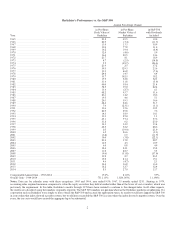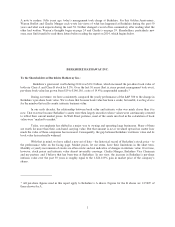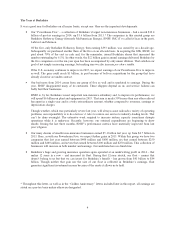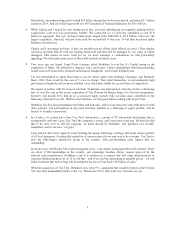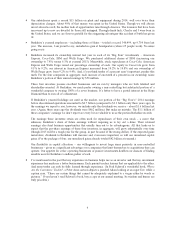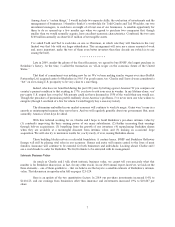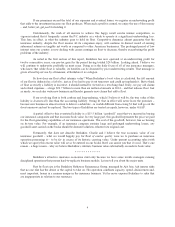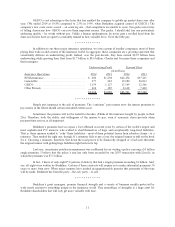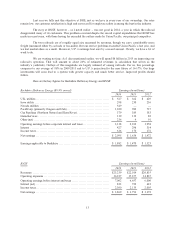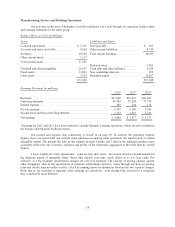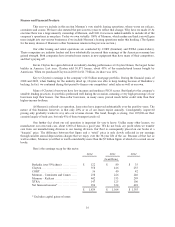Berkshire Hathaway 2014 Annual Report Download - page 14
Download and view the complete annual report
Please find page 14 of the 2014 Berkshire Hathaway annual report below. You can navigate through the pages in the report by either clicking on the pages listed below, or by using the keyword search tool below to find specific information within the annual report.Regulated, Capital-Intensive Businesses
We have two major operations, BNSF and Berkshire Hathaway Energy (“BHE”), that share important
characteristics distinguishing them from our other businesses. Consequently, we assign them their own section in
this letter and split out their combined financial statistics in our GAAP balance sheet and income statement.
A key characteristic of both companies is their huge investment in very long-lived, regulated assets, with
these partially funded by large amounts of long-term debt that is not guaranteed by Berkshire. Our credit is in fact
not needed because each company has earning power that even under terrible economic conditions will far exceed
its interest requirements. Last year, for example, BNSF’s interest coverage was more than 8:1. (Our definition of
coverage is pre-tax earnings/interest, not EBITDA/interest, a commonly used measure we view as seriously flawed.)
At BHE, meanwhile, two factors ensure the company’s ability to service its debt under all circumstances.
The first is common to all utilities: recession-resistant earnings, which result from these companies offering an
essential service on an exclusive basis. The second is enjoyed by few other utilities: a great diversity of earnings
streams, which shield us from being seriously harmed by any single regulatory body. Recently, we have further
broadened that base through our $3 billion (Canadian) acquisition of AltaLink, an electric transmission system
serving 85% of Alberta’s population. This multitude of profit streams, supplemented by the inherent advantage of
being owned by a strong parent, has enabled BHE and its utility subsidiaries to significantly lower their cost of debt.
This economic fact benefits both us and our customers.
Every day, our two subsidiaries power the American economy in major ways:
• BNSF carries about 15% (measured by ton-miles) of all inter-city freight, whether it is transported by
truck, rail, water, air, or pipeline. Indeed, we move more ton-miles of goods than anyone else, a fact
establishing BNSF as the most important artery in our economy’s circulatory system.
BNSF, like all railroads, also moves its cargo in an extraordinarily fuel-efficient and environmentally
friendly way, carrying a ton of freight about 500 miles on a single gallon of diesel fuel. Trucks taking on
the same job guzzle about four times as much fuel.
• BHE’s utilities serve regulated retail customers in eleven states. No utility company stretches further. In
addition, we are a leader in renewables: From a standing start ten years ago, BHE now accounts for 6% of
the country’s wind generation capacity and 7% of its solar generation capacity. Beyond these businesses,
BHE owns two large pipelines that deliver 8% of our country’s natural gas consumption; the recently-
purchased electric transmission operation in Canada; and major electric businesses in the U.K. and
Philippines. And the beat goes on: We will continue to buy and build utility operations throughout the
world for decades to come.
BHE can make these investments because it retains all of its earnings. In fact, last year the company
retained more dollars of earnings – by far – than any other American electric utility. We and our
regulators see this 100% retention policy as an important advantage – one almost certain to distinguish
BHE from other utilities for many years to come.
When BHE completes certain renewables projects that are underway, the company’s renewables portfolio
will have cost $15 billion. In addition, we have conventional projects in the works that will also cost many billions.
We relish making such commitments as long as they promise reasonable returns – and, on that front, we put a large
amount of trust in future regulation.
Our confidence is justified both by our past experience and by the knowledge that society will forever
need massive investments in both transportation and energy. It is in the self-interest of governments to treat capital
providers in a manner that will ensure the continued flow of funds to essential projects. It is concomitantly in our
self-interest to conduct our operations in a way that earns the approval of our regulators and the people they
represent.
12


